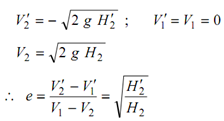Solution to Problems of Direct Central Impact:
With the additional Eq. (6), all of the five unknowns may be determined to analyse the complete problem. The difficulty referred above has direction of impact along the line joining centres of the two masses. This kind of impact is referred to as direct central impact. Solving out Eqs. (2) and (3).
m1 (Vc - V1) = - m2 (Vc - V2)
Vc (m1 + m2) = m1 V1 + m2 V2
Solving Eqs. (4) and (5)
m1 (V1′ - Vc) = - m2 (V2′ - Vc)
or m1 V1′ + m2 V2′ = Vc (m1 + m2 )
From Eqs. (7) and (8), we note down that
m1 V1 + m2 V2 = m1 V1′ + m2 V2′ = (m1 + m2 ) Vc
Which is nothing however the principle of conservation of linear momentum.
Considering ratio of Eqs (2)/ (3) and (4)/(5)
m1 (Vc - V1 ) / m2 (Vc - V2 ) = m1 (V1′ - Vc ) /m2 (V2′ - Vc ) = - 1
Also Eqs. (2) /(4) and (3) /(5) = 1/ e gives
Vc - V1 / V1′ - Vc = Vc - V2 / V2′ - Vc = 1/ e
∴ e (Vc - V1 ) = V1′ - Vc
And e (Vc - V2 ) = V2′ - Vc
Eqs. (10(a)) and (10(b)) shall eliminate unknown Vc and provide
C (V2 - V1 ) = V1′ - V2′
i.e. Coefficient of restitution
e = V1′ - V2′ / V2 - V1 = (V2′ - V1′) / V1 - V2
∴ e = Velocity of departure / Velocity of approach
If the coefficient of restitution for steel to steel is to be attained experimentally, the simplest method would be to take a spherical solid steel ball and drop it over horizontal steel plate kept on a rigid platform from a apparent height H2 and measure the height H2′ to which it can rise

Note that final velocity of the two masses may be determined analytically, with the help of only two Eqs. (9) and (10(c)), if value of e is known.